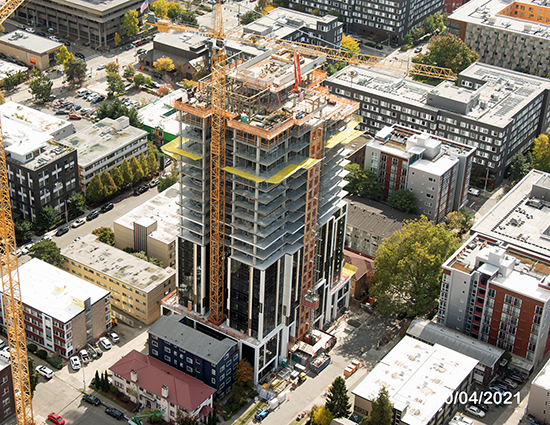
 |
May 20, 2022
Grand Award: Safety
Construction Manager more than 250K hours

Exxel Pacific
Exxel Pacific moves forward with one eye on what has made it successful to this point, and another eye on “change” that will make it better in the future.
Exxel’s Dropped Object Protection Program has been in place for over five years, and it has been extremely successful since its inception. It focuses on pre-planning of dropped objects from projects and overhead operations including scaffolds and aerial lifts. Exxel’s purple netting is used at openings where materials could fall. Tool lanyards and tie-back methods are also utilized to help protect from falling tools and equipment.
As Exxel’s portfolio progresses into projects that have more levels and building towers in the urban core of Seattle, the hazard of dropped objects grows and Exxel is continually looking at proactive physical change. Exxel is currently constructing a student housing project with 22 levels in a very tight area of the University District. There are neighboring buildings within feet of this project. With very little room around the perimeter, Exxel knows some tried and true methods needed to advance.
One advancement of Exxel’s program was to install debris outrigger nets. It is an engineered debris net system, using poles that extend out from the building approximately 20 feet and extend over the property lines. Between the poles are layers of reinforced netting to capture any additional items that could accidentally come out from the building. The nets trail the active working deck and are advanced at each deck cycle.
The nets are always kept within five levels of the top deck. At the end of the shift, the nets are pulled back and debris, if any, is removed to ensure it’s not pre-loading the net or could possibly come dislodged during a wind event. The net systems caught nails and small pieces of debris from coming down on an active project.
A second advancement Exxel deployed on this project was from a lesson-learning session. A freak accident occurred when a concrete troweling fan blade came loose of the spinning troweling machine, cutting through the typical netting. Through investigations, Exxel determined a fastener had broken during operation and allowed the fan blade to come off the machine. The root cause, mechanical failure of the machine, was remedied by using a different method to attach the fan blades, but Exxel also recognized that it could implement more robust controls to the typical perimeter netting. The Exxel team researched many different types of reinforced netting. Most didn’t have cut protection to provide the control Exxel was looking for. Exxel found its solution from the fishing industry and procured a netting that had Dyneema woven in. Dyneema is a steel fiber woven material found in cut-resistant gloves that are used in the construction industry. This net was layered on the active top deck of the project to provide a cut-resistant barrier to the active deck and is a best practice for Exxel concrete towers going forward.
Copyright 2020 Seattle Daily Journal of Commerce

